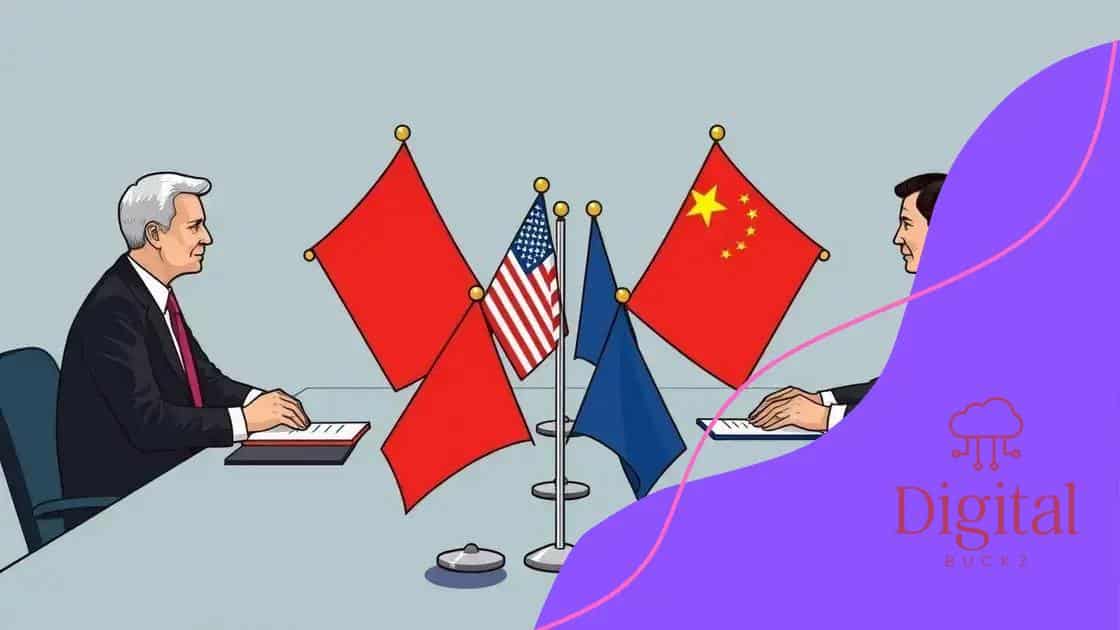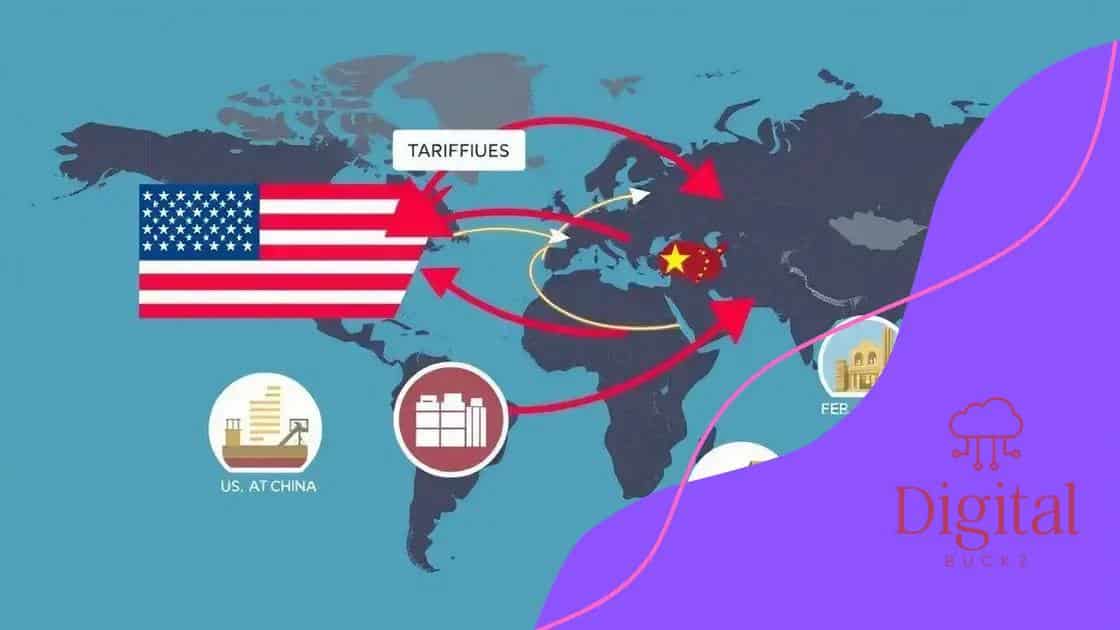US-China tariff negotiations Geneva: What’s at stake?

US-China tariff negotiations significantly influence global trade dynamics, impacting pricing, market access, and economic relations, while determining the future trade landscape for multiple industries.
US-China tariff negotiations Geneva have captured the attention of global markets. You might wonder how these talks affect prices and trade dynamics. Dive into the essential details that matter.
Understanding the US-China trade relationship
The US-China trade relationship is a critical aspect of global economics. Understanding this relationship helps us see how trade affects jobs, prices, and international policies.
Traditionally, the US and China have been major trading partners. Yet, tensions have arisen over tariffs and trade practices. It’s essential to grasp the factors influencing these dynamics.
Key Factors in the Trade Relationship
Several elements play a role in defining the US-China trade relationship:
- Imports and Exports: The US imports a significant amount from China, including electronics and apparel. In return, the US exports agricultural products and technology.
- Tariff Impacts: Tariffs can raise costs for consumers on both ends. Understanding these impacts is crucial for businesses and customers alike.
- Economic Policies: Both countries have different economic strategies, which affect trade negotiations and agreements.
As trade tensions escalate or decline, the US-China trade relationship evolves. Recent negotiations focus on addressing imbalances and improving cooperation.
Future of Trade Relations
Looking ahead, experts predict changes in various sectors due to shifting policies. The future depends not just on negotiations but also on global market trends.
Investors and consumers must stay informed as these developments impact our economies. As policies shift, so do opportunities for new ventures and challenges for existing businesses.
Understanding the US-China trade relationship reveals much about today’s economy. By following these trends, individuals and companies can better navigate the changing landscape of global trade.
Overview of tariff negotiations in Geneva
The tariff negotiations in Geneva are significant for global trade. These discussions focus on resolving disputes and establishing new rules for international commerce.
Countries affected by tariffs engage in talks to find common ground. With the economic stakes high, stakeholders closely monitor these negotiations.
Key Aspects of the Negotiations
Several elements define the tariff negotiations:
- Parties Involved: Major economies, including the US and China, are principal actors in these discussions.
- Goals: The primary aim is to reduce trade barriers and foster better international relations.
- Implications: These negotiations can lead to changes in market access, affecting many industries.
As talks progress, the atmosphere may shift between cooperation and tension. Each round of negotiations reveals differing priorities and strategies among nations.
Recent Developments
In recent meetings, participants have discussed new strategies to tackle existing tariffs. There’s a focus on transparency and fairness in the negotiation process.
Constant updates arise, especially regarding agricultural products and technology tariffs. These areas impact both economies significantly, driving further discussions.
The tariff negotiations in Geneva represent a crucial moment in trade history. By engaging in dialogue, countries aim to create a more stable trading environment globally.
Key consequences of the negotiations

The key consequences of the negotiations between the US and China can significantly impact global economies. These discussions shape trade policies that affect countries beyond just the two powers involved.
One major consequence lies in tariff adjustments. Changes in tariffs can lead to shifts in prices and supply chains, influencing everything from consumer goods to raw materials. Understanding these impacts helps businesses and consumers navigate the market landscape.
Economic Impacts of Tariff Changes
As tariffs shift, various sectors feel the effects:
- Manufacturing: Increased tariffs can raise costs for manufacturers, who may pass these expenses onto consumers.
- Agriculture: Farmers and agricultural exporters may face barriers to their markets, potentially leading to declines in exports.
- Employment: Job security in affected industries can fluctuate as companies adjust their operations in response to tariff changes.
These factors demonstrate how intertwined global economies are. When one country alters trade agreements, ripple effects are felt worldwide.
Political Ramifications
Beyond economic consequences, political relationships also change as negotiations progress. Nations may strengthen alliances or grow more competitive based on the outcomes of the talks.
Trade negotiations encourage diplomacy and collaboration. When countries work together toward a common goal, they can create stable trade environments. However, if negotiations fail, it could lead to strained relations and heightened tensions.
The key consequences of the negotiations highlight the complexity of international trade. Each decision made in these discussions has the potential to create far-reaching impacts, influencing economies and relationships across the globe.
Potential outcomes and global impact
The potential outcomes and global impact of the US-China tariff negotiations play a crucial role in determining the future of international trade. As these two economic giants negotiate, the effects are felt not only within their borders but around the globe.
A key area of focus is how tariffs influence pricing and availability of goods. For instance, if tariffs increase, the prices of imported products may rise. Consumers can expect to pay more for everything from electronics to clothing, which affects purchasing behavior.
Impact on Global Trade
The outcomes of these negotiations can reshape global trade dynamics:
- Trade Relationships: Countries that rely on exports to the US or China might experience changes in trade balances.
- Supply Chains: Businesses may seek new sourcing strategies to minimize costs, leading to shifts in where products are manufactured.
- Market Stability: The uncertainty from tariff negotiations can lead to volatility in financial markets as investors react to news.
As the negotiations unfold, the broader implications regarding economic policies and alliances come into play. Nations may realign their trade strategies based on the results, potentially strengthening ties with other countries affected by these decisions.
Industry-Specific Effects
Specific industries face unique challenges depending on how tariffs are structured. For example, agriculture has been significantly impacted, as farmers navigate shifting markets and demand.
Technology and manufacturing sectors also face critical decisions regarding investments and operations. Companies must adapt quickly to remain competitive in a changing landscape.
The potential outcomes and global impact of these negotiations illustrate how interconnected the world is. When large economies adjust their trade policies, the ripple effects reach far beyond their borders.
Future of US-China trade relations
The future of US-China trade relations remains uncertain and highly anticipated. As both countries navigate their economic strategies, the outcomes of recent negotiations will shape the landscape of international trade for years to come.
Current tensions have forced both nations to reconsider their trade policies. This reevaluation doesn’t just impact tariffs, but also influences other areas like technology transfer and market access. Stakeholders from various sectors are investing efforts to adapt to changes that can emerge from these discussions.
Impact of Ongoing Negotiations
As negotiations continue, the potential directions of US-China trade relations include:
- Increased Cooperation: There is hope for a more collaborative approach, focusing on mutual benefits and reducing tariffs.
- Market Access: Changes may allow greater access to each nation’s markets, improving opportunities for exporters.
- Long-term Agreements: Establishing stable trade agreements could promote predictability and confidence for businesses.
Ultimately, the fate of trade relations will significantly depend on how both nations choose to engage with one another. This balance is crucial, as it impacts both economies and the global market.
Emerging Trends and Challenges
New trends may emerge as the negotiations unfold. For instance, companies might increase investments in technology to maintain competitiveness amidst changing tariffs. Additionally, supply chains may shift based on the evolving relationship, requiring businesses to adapt their sourcing strategies.
However, challenges remain. Political climates in both countries could lead to unexpected hurdles, influencing how trade is conducted. It will take strategic planning from both sides to navigate these complexities.
Monitoring the future of US-China trade relations is essential for businesses, policymakers, and consumers alike. Understanding how this relationship evolves can provide insights into economic trends and opportunities across the globe.
Conclusion:
The ongoing tariff negotiations between the US and China have far-reaching implications. As both countries strive for better trade relations, the potential outcomes can reshape the global economy. Consumers, businesses, and governments need to stay informed about these developments. By understanding the challenges and opportunities that arise from these negotiations, all parties can better navigate the landscape of international trade.
FAQ – Frequently Asked Questions about US-China Tariff Negotiations
What are the main issues discussed in US-China tariff negotiations?
Main issues include tariff rates, market access, and trade imbalances that impact both economies.
How do tariffs affect consumer prices?
Tariffs can lead to higher prices for imported goods, as businesses may pass on the additional costs to consumers.
What industries are mostly impacted by these negotiations?
Key industries affected include technology, agriculture, and manufacturing, as they are heavily influenced by trade policies.
How can individuals stay informed about trade negotiations?
Individuals can follow news outlets, trade organizations, and official government announcements to stay updated on negotiations.






